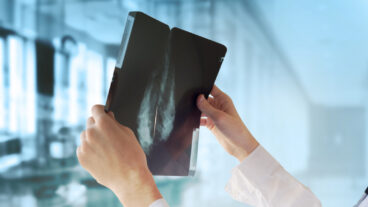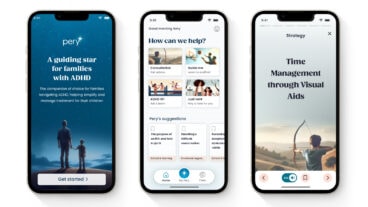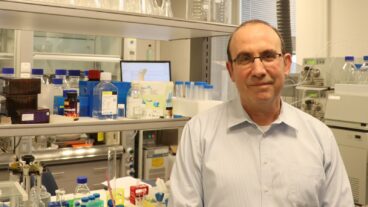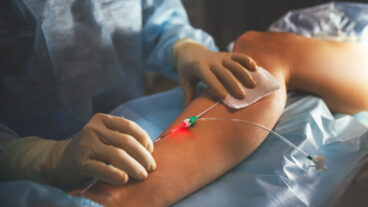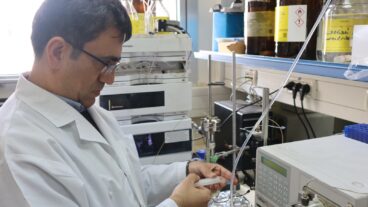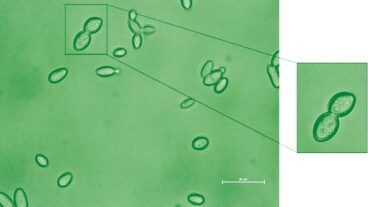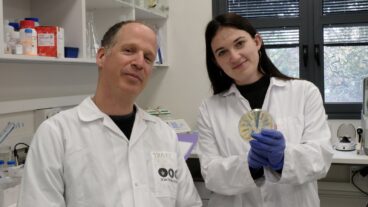Senior anesthesiologists Drs David Gozal (left) and Yaacov Gozal. The brothers have been an integral part of the Hadassah team which has operated on Prime Minister Ariel Sharon. (Photo: Avi Hayoun)The international media is currently camped outside the Hadassah Medical Center Ein Kerem because it is the hospital where Israeli Prime Minister Sharon has been operated on for a cerebral hemmorhage. But in addition to serving as a high level treatment facility, the hospital is also an international center for cutting-edge medical research.
The most important ongoing research projects were highlighted at a recent briefing for health reporters. They include the testing of an exciting new vaccine aimed at preventing HIV from developing into deadly AIDS. The research is focusing on reversing the destruction of the immune system that gives Acquired Immune Deficiency Syndrome (AIDS) its name.
Close to a million cases of AIDS have been diagnosed in the US since the beginning of the epidemic, with the HIV/AIDS virus claiming over 20 million lives. Another 39 million people are currently estimated to be living with HIV/AIDS worldwide.
In the past, researchers have noted that even after a cocktail of drugs kills off the HIV virus in patients, the white blood cell count continues to fall.
“The cocktail only works against the virus – but there is another process going on,” said Dr. Rivka Abulafia-Lapid, Director of Hadassah’s Center for Vaccination Laboratory.
Abulafia-Lapid contended that aside from the destruction of the white blood cells wrought by the HIV virus, the second process causes auto-immunity, a state in which the body’s immune system attacks itself.
She explained that although the HIV virus kills the CD4 white blood cells that are the immune systems’ stormtroopers in the fight against infections, the AIDS vaccine is aimed at the immune system itself and not the virus infection.
This leaves unabated the process by which some white blood cells, labeled CD8 cells, become confused as to which other cells they should be attacking. As a result, they intercept healthy CD4 white blood cells, killing them off. So although it is rid of the HIV virus, the immune system continues to deteriorate, leaving patients undefended against the wide variety of viruses that a healthy body contends with as a matter of course.
To generate the new vaccine, researchers draw blood from HIV patients and then separate off the errant CD8 white blood cells. After killing the cells, researchers then inject them back under the skin of the original patients in a manner similar to other vaccines, such as tetanus.
The body’s immune system reacts to the intruders and, having identified the CD8 cells as hostile, proceeds to continue killing all similar CD8 cells in the body.
“It is using the body’s natural systems,” Abulafia-Lapid said.
Beginning in 1998, Hadassah researchers began testing eight patients infected with the HIV sub-type B virus strain that is common in Europe and America, and then another five patients infected with sub-type C found in Africa.
The patients, who were also taking a drug cocktail to kill off the HIV virus, received three injections of 10 million CD8 white blood cells. The first eight patients finished the course in 2002, but the final five are still undergoing treatment. Injections were given when the patients’ CD4 white blood cell counts were below 500 cells per micro-liter.
Abulafia-Lapid reported that following the first injection, there was a great improvement in the CD4 white blood cell count and that each time the cells count flagged patients were given another shot.
CD4 white blood cells counts continued to increase in a reversal of the usual progression of the HIV and AIDS diseases. In addition patients showed no side-affects from the vaccine. When the CD4 white blood cells count drops below a crucial threshold level of 200 cells per micro-liter patients usually develop acute AIDS and die within ten years.
Abulafia-Lapid said researchers are trying to change AIDS from an acute disease to a chronic disease by greatly increasing the lifespan
of patients.
Researchers are now set to begin a larger study on more patients and then will embark on a multi-center study involving patients at a variety of locations.
In addition, there are efforts underway to develop a protein vaccine to replace the current 21-day process of growing the vaccine cells. A protein vaccine would lead to a generic injection that could be used by all patients circumventing the need to produce tailor-made CD8 cells.
Abulafia-Lapid said the same technology may also be applied to multiple sclerosis another degenerative disease.
Meanwhile oral medicine specialist and researcher Dr. Doron Aframian is developing a method to bring relief to a common side effect of chemotherapy in patients suffering from head and neck cancers. The chemotherapy radiation, while killing off the cancer, growths also destroys the saliva glands leaving patients with a dry mouth that in addition to being uncomfortable can bring on a host of additional ailments.
“Saliva is the aqua-vita of the oral cavity,” Aframian said, and explained that saliva protects the integrity of the mouth tissue, both hard and soft, as well as the upper intestinal tract. Consisting of 99% water and 1% biologically active proteins, saliva lubricates, aids digestion and assists with swallowing and speech. In addition the more than 500cc of saliva produced in a health mouth everyday also protects teeth against cavities, the gums against gingivitis and helps clot the blood in mouth wounds.
There are some 500,000 new head-and-neck cancer patients every year, with 40,000 in the US alone, and at present there is no efficient therapy to prevent the saliva gland destruction during chemotherapy. Instead patients apply drugs and creams to artificially induce salivation after treatment.
Now Aframian is seeking to make artificial glands, using tissue engineering, adult stem cell biology and gene therapy.
Adult stem cells are cells that remain in the body after the fetus develops and that have the potential to grow into any cell type albeit with a little nudge from medical science. Stem cells help normal body tissue regenerate itself. These precious cells, already scarce in saliva glands, are very sensitive to radiation.
By ‘fishing’ for stem cells in the saliva glands before the start of chemotherapy, Aframian hopes to grow new saliva glands around a biocompatible
scaffold. At the end of the chemotherapy that typically lasts a month, the regenerated glands will be implanted in the patient¹s mouth to replace those destroyed by the treatment.
So far, tests on mice and rats have been encouraging though delicate handiwork. Whereas the human scaffolds will be several centimeters long, Aframian used microsurgery to install the rodent-sized test devices that were only two millimeters long and 0.5mm thick.
The work is so specialized that the team of Dr. Aaron Palmon in Hadassah, Professor Bruce Baum of National Institute of Health in Baltimore, Maryland and Aframian are the only researchers working on it anywhere in the world.
Aframian intends to apply for permission from the Helsinki Committee to grow human adult stem cells and then proceed to building human saliva
glands.





